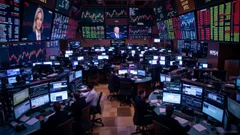AInvest Newsletter
Daily stocks & crypto headlines, free to your inbox
The digital marketing landscape is undergoing a seismic shift. Generative AI tools—once the realm of science fiction—are now the engines of scalability and profitability for brands. From
to JP Morgan, companies are harnessing AI-driven content creation to slash costs, amplify reach, and outpace competitors. But this isn't just about efficiency; it's a new paradigm where ROI is quantifiable, measurable, and transformative. Here's why investors must act now.
The era of “good enough” content is over. AI tools are rewriting the rules of speed and cost. Consider these metrics:
- Heinz's 2024 DALL-E campaign generated 7 million unique ketchup bottle designs, yielding 800 million earned impressions—a 2,500% return on media spend.
- Bloomreach boosted blog output by 113% using Jasper AI, driving a 40% traffic surge with no added人力 costs.
- Cyber Inc. scaled global video content production via Synthesia, cutting localization time by 90%.
The math is clear: AI reduces operational costs by 43% while enabling hyper-personalization at scale. A 2025 Gartner study reveals that businesses using AI tools have cut content production time by 40%, with SEO rankings improving by 30% through data-driven keyword optimization.
Adobe, a leader in AI-integrated marketing tools, has outpaced the S&P 500 by 22% in 2024 alone, reflecting investor confidence in its AI-powered cloud solutions.
The real game-changer is the measurable ROI these tools deliver:
- Coca-Cola's “Share a Coke” campaign, personalized via AI, increased sales by 2% and drove an 870% surge in social media engagement.
- Verizon reduced customer churn by proactively offering personalized retention deals via AI, boosting lifetime value by 30%.
- JP Morgan Chase saw 450% higher click-through rates using Persado's AI-generated copy—a cost-per-click reduction of 76%.
The $467 billion AI software market by 2030 (growing at a 29% CAGR) isn't just a projection. It's a reflection of reality: 85% of marketers plan to boost AI spending in 2025, with only 4% refusing adoption.
The market is projected to grow from $2.9 billion in 2024 to $7.74 billion by 2029—a 21.6% CAGR—driven by demand for scalable, data-driven content.
Critics cite hurdles like data fragmentation, trust gaps, and ethical concerns. But the leaders are already ahead:
- Unified data ecosystems: 55% of executives are prioritizing real-time data integration to fuel AI's potential.
- Ethical frameworks: Adobe, Microsoft, and Salesforce embed transparency and bias checks into their tools.
- Hybrid workflows: Humans handle strategy; AI handles grunt work—a model yielding 50% more creative output with zero quality loss.
Even skeptics are converting: 76% of marketers now see AI as essential, not optional.
The winners are clear. Buy into the ecosystem:
1. Adobe (ADBE): Its AI-powered Creative Cloud and analytics tools dominate the market.
2. Microsoft (MSFT): Its partnership with OpenAI and Azure AI tools are enterprise gold standards.
3. Salesforce (CRM): Its Einstein AI platform integrates CRM data with content creation.
4. Niche innovators: Jasper AI (pre-IPO) and Persado are cornering the automation space with proven ROI.
While Tesla's trajectory shows volatility, tech leaders like Microsoft and Adobe offer steady growth tied to AI adoption—a safer bet for ROI-focused investors.
The window for early adoption is closing. Brands like Nutella and Sephora have already shown how AI can turn content into a revenue engine. With $220 billion of generative AI spend by 2030, the question isn't if you should invest—it's how quickly.
The data is undeniable. The tools are here. The ROI is proven. This is the moment to stake your claim in the AI content revolution. The future belongs to those who code creativity with algorithms—and profit handsomely from it.

Tracking the pulse of global finance, one headline at a time.

Dec.20 2025

Dec.20 2025

Dec.19 2025

Dec.19 2025

Dec.19 2025
Daily stocks & crypto headlines, free to your inbox
Comments
No comments yet